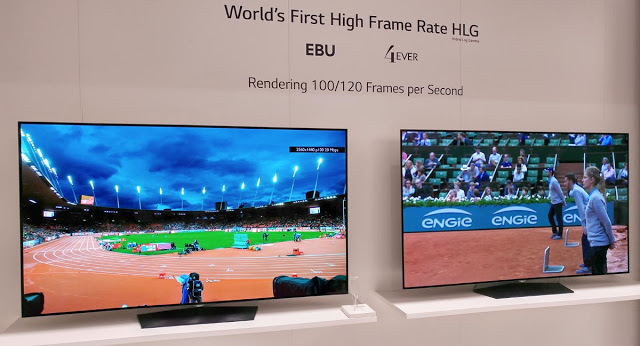DVB tuners are used in all European TVs to receive broadcast channels. The next DVB standard will support much improved picture and audio quality, allowing broadcasters to leap forward.
HDR and HFR picture quality:
USA is using a different TV tuner platform but DVB is used throughout Europe and some other regions. Modern DVB tuners already support 4K UHD resolution as part of ”DVB UHD-1 Phase 1”. A few European broadcasters have taken advantage of this to launch UHD channels.
The next step is HDR and HFR:
HDR is short for “High Dynamic Range” and extends the dynamic range and color gamut. HFR is short for ”High Frame Rate” and refers to a frame rate higher than 50/60Hz – up to 120 frames per second – for extremely smooth video. HFR is a perfect match or sports and nature documentaries for example.
The industry sees HFR as the next major improvement in picture quality. The first HFR capable TVs are expected to launch in 2017.
The new specification goes under the title ”DVB UHD-1 Phase 2” (or ”audio-visual coding specification TS 101 154”) and has been approved by the DVB consortium. It now needs to be formally approved ETSI.
– "Today’s approval of the specification is the result of enormous effort from the contributors, and further evidence of DVB’s leadership in the broadcast industry. DVB views the extended audio-visual coding specification as a key enabler for exciting new products and services," said Peter MacAvock, DVB Chairman.
DVB tuners based on the new standard will be capable of handling the improved picture quality by using one of two formats: PQ (Perceptual Quantizer) or HLG (Hybrid Log Gamma). The PQ base is the same being used for streaming and UHD Blu-ray. HLG is a new format developed by the broadcast industry, designed to take into account legacy TVs. HLG enables broadcasters to package an HDR version and a SDR version of the video into the same signal. HDR TVs will automatically detect the added picture information while SDR TVs will disregard it.
Improved audio too:
The new DVB tuner standard will also include support for improved audio. The DVB group refers to it as NGA, short for ”Next Generation Audio”. It is an industry term for a group of new audio formats, including scene and object based formats such as Dolby Atmos and DTS:X.
– “It’s a great team effort that marks the culmination of the most intense year of work in TM-AVC’s history, 21 years after the first version of the specification was published as BlueBook 001," said Ken McCann, Chair of TM-AVC under the DVB group.
Now up to the broadcasters:
The DVB group expects to finalize the last formal details next year. After that it is up to TV broadcasters to adopt the new technologies. No broadcasters have outlined formal plans to support HDR or HFR.
TV channels in Europe are generally broadcast in either 720 or 1080i HD. Some broadcasters have launched their first UHD channel in 2015 or 2016.
”Could be available from next year”
Instead, streaming providers such as Netflix, Amazon, and YouTube have taken the innovation lead. 4K UHD was introduced a few years ago and HDR added earlier this year. Broadcasters are hoping to catch up and the new DVB standard is the first important step to realize those plans.
The new standard supports three new technologies – namely HDR, HFR and NGA – and the DVB group expects broadcasters to adopt the HDR layer first.
– ”This will enable DVB services offering UHDTV with HDR. This would be the first element of UHD-1 Phase 2 features to be implemented and could be available from next year,” the DVB group said.
All major manufacturers are DVB members, including LG, Samsung, Sony, Panasonic and Philips. It will require a new TV with an updated tuner to enjoy the new technologies. The alternative is to connect an external set-top box.
fonte


